![]()
![]()
![]()
Use LEFT and RIGHT arrow keys to navigate between flashcards;
Use UP and DOWN arrow keys to flip the card;
H to show hint;
A reads text to speech;
17 Cards in this Set
- Front
- Back
|
Characteristics of Brucella
|
-All Brucella genetically highly related
-Small, non-motile Gram- rods -MZN+ -Has 2 chromosomes -Obligate parasites: intracellular multiplication; predilection for repro organs -Selective media: CO2 enhances growth -Commonest zoonotic infection in the world -- usually lab acquired |
|
|
Brucella abortus characterisitics
|
-Cattle mainly affected
*Zoonosis: humans get intermittent fever -Aborting cow = 10^9 - 10^10 CFU/g fetal fluids of B. abortus -Survive up to 4-6 months in the environment -Ingestion most common route (10^4 = infectious dose) -Abort at >20 wks |
|
|
Brucella abortus pathogenesis
|
-Chronic disease, persists for life
-Pregnant animals abort only after initial infection; will shed Brucella during parturition in subsequent pregnancies -Non-pregnant animals: organisms localize to spleen, mammary gland, and lymphatics -Bulls: Organisms localize to vesicles, testes, epididymus; causes orchitis; transmission via contaminated semen |
|
|
Brucella abortus clinical signs
|
-Pregnant animals: abortion at >20wks; abortion storms in herds with many susceptible cows
-Infected cows usually abort once; Calves born from later pregnancies may be weak and unhealthy -Calves become susceptible to infection as the approach the breeding age -Affected herds: decreased fertility, reduced milk production, abortions in replacement animals, testicular degeneration in bulls |
|
|
Diagnosis of Brucella abortus
|
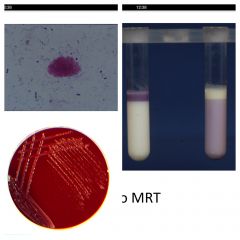
-Serology (buffered B. abortus Ag tests), microscopy (MZN) and isolation of the organism (10% CO2)
-Specimens: *Fetus - whole fetus, fetal abomasal contents, fetal lesions, placenta *Dam - uterine discharges, colostrum, milk, paired serum samples *Bull - semen -Typing of the organism: biochemical and molecular (PCR) -Antibody tests -Milk ring test or ELISA |
|
|
Control of Brucella abortus
|
-National eradication: test and slaughter
-Reactors: isolate, disinfect, discard milk, depopulate -Abortions: notify, isolate, fetus to lab -Vaccination: live attenuated vaccines (RB51 and B. abortus 19) *B. abortus 19 compromises serological tests (can't tell btw infected and vaccinated animals) *RB51 preferred in many countries |
|
|
Where are remaining cases of B. abortus found in USA?
|
In free ranging bison in Yellowstone National Park
|
|
|
Brucella melitensis
|
-Affects goats and sheep (goats probably more susceptible) in the Mediterranean/Middle East/South America
-Infection in goats resembles B. abortus in cattle --> high abortion rates, orchitis in rams, arthritis -Persistent infection: shedding of organisms in milk --> public health risk -Control: *test and slaughter *Rev.1 B melitensis live attenuated vaccine: lambs/kids <6mo (life long immunity); still retains some virulence (abortions in pregnant goats, risk to humans) |
|
|
Brucella melitensis as a human pathogen
|
-Occupational hazard
-Difficult to treat: doxycycline or in combo with streptomycin -No vaccine for humans -1st weaponized pathogen! *resistant to drying, survives well in environment *B. melitensis causes the most severe disease follow by B. suis > B. abortus > B. canis |
|
|
Brucella ovis
|
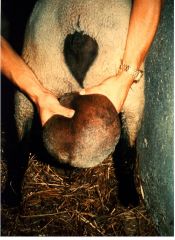
-In sheep only
-Epididymitis in rams, placentitis in ewes -Venereal transmission -Reduced fertility, abortion, increased perinatal morality -Control: Rev 1 vaccine -NOT zoonosis |
|
|
Brucella suis
|
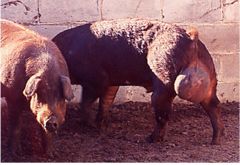
-Affects pigs in Central/South America/Asia
-Causes abortion in sows, orchitis in boars -Oral and venereal transmission -Prolonged bacteremia: localizes in wide range of tissues -Control: test and slaughter; NO vaccine!! |
|
|
Brucella canis
|
-Affects dogs in USA/Japan/Central & South America
*Possibly exotic in Ireland: serologically + animals found here -Rough/weaker pathogen -Oral and venereal transmission -Enlarged lymph nodes -Causes abortion in females, orchitis/epididymitis in males -Treatment: prolonged antiobiotic treatment, difficult to clear infection (don't treat breeding animals), NO vaccine |
|
|
Campylobacter characteristics
|
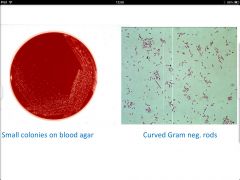
-Gram - curved rods; small colonies
-Normal flora of many animals -Motile -Microaerophilic -C. jejuni is thermophilic -Selective medium |
|
|
Camplylobacter fetus subsp. venerealis
|
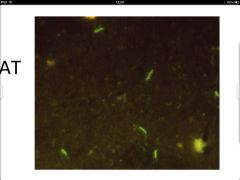
-Bovine Genital Camplylobacteriosis = infertility in cattle!!
-Asymptomatic carrier bulls >4yrs old -Transmitted during coitus -Heifers mostly affected: develop an Ab-mediated immunity after infection lasting 2-4yrs -Clinical signs: abortion in heifers, infertility, long estrus cycles -Pathogenesis: S-layer = virulence factor *S-layer can switch on/off allowing Ag shifts *Promotoes perisistence/carrier states -Diagnosis: *cervo-vaginal mucus ] *preputial washings/smegma ]--FAT *fetal abomasal contents ] *PCR -Control: vaccine (Bacterin) for problem herds (not available in Ireland), antibiotics in bulls *Limited efficacy in clearing organisms from vagina/cervix |
|
|
Campylobacter fetus subsp. fetus
|
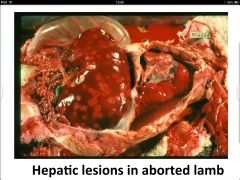
-Ovine Genital Campylobacteriosis
-Affects sheep (and cattle) -Causes sporadic abortions -Intestinal commensal -Pathogenesis: bacteremia, localization in the uterus, placentitis, abortion in the 2nd-3rd trimester -Recovered ewes immune (~3yrs) -Diagnosis: clinical signs, fetal hepatic lesions, culture -Control: isolation of aborting ewes, antibiotic treatment (chlorotetracycline), vaccination (dead vaccine- Bacterin) -C. jejuni is a similar syndrome that leads to abortion *more common in Ireland than C. fetus subsp. fetus *Vaccine does NOT protect against C. jejuni |
|
|
Enteric Campylobacteriosis
|
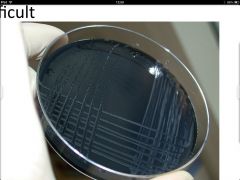
-Caused by Campylobacter jejuni, C. coli, and C. lari
-Normal flora of birds and animals so attributing cause/effect is difficult -Causes occasional diarrhea in animals: most cases reported in dogs -Major public health significance: C. jejuni is most frequent cause of human bacterial diarrhea -Diagnosis: direct microscopy (DCF stained smears), isolation on charcoal based selective medium *interpretation of findings difficult: healthy animals can shed Campylobacter!! |
|
|
Lawsonia intracellularis
|
-Slender, curved, Gram- rods
-CANNOT be grown on an agar plate -Grown in enterocyte cell lines -Porcine proliferative enteropathy: inflammation of terminal small and large intestine, chronic diarrhea to hemorrhagic enteropathy -Diagnosis: immunofluorescent staining of feces or ileal mucosa, PCR -Treatment/control: antibiotics, vaccine available; disinfection/cleaning after outbreak |

